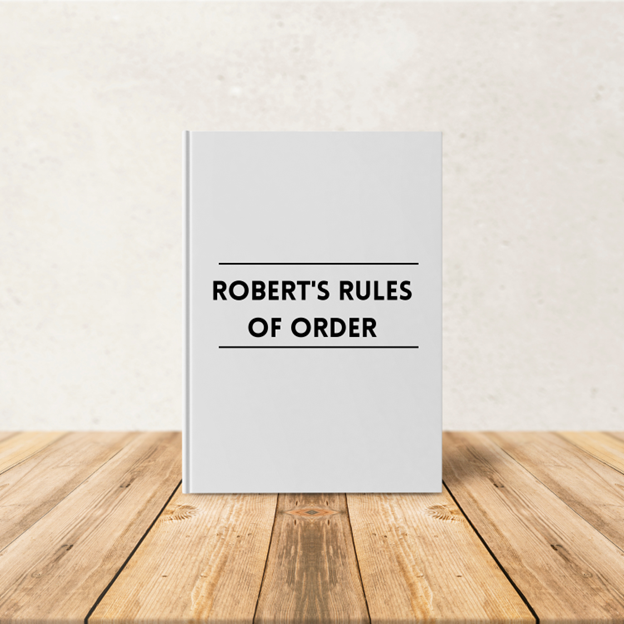If you're a board member of a community association, it's important that you familiarize yourself with and follow Robert’s Rules of Order. This article will give you some background information on the rules and how they relate to homeowner’s association (HOA) meetings.
What are Robert's Rules of Order?
Robert's Rules of Order is essential to conducting orderly, organized, and fair meetings. Written by Henry Roberts and first published in 1876, Robert’s Rules outlines the rules, tactics, procedures, and etiquette for formal deliberative assemblies like HOA meetings. Today, it is used to preserve order and keep everyone on track, so everyone has a chance to be heard. It also ensures that no one person or side can dominate the discussion or take control of the meeting. Because of its long-standing tradition as a standard for proper decorum in official discussions, many organizations rely on Robert’s Rules to maintain order and ensure that members are all informed and on the same page during meetings.
Who presides over the meeting? What are their duties?
The meeting chairperson abiding by Robert's Rules of Order holds a significant role in the proceedings. Their duties include calling the meeting to order, recognizing members to speak and vote, enforcing the rules of procedure, and ensuring the discussion stays on task. They also conduct procedural voting and issue rulings on points of order or mistakes that have been made during the course of the meeting. With their authority as chairperson, it is essential that they remain impartial in any debates or discussions. The importance of a chairperson who upholds Robert's Rules in a community association meeting is evident when considering how these procedures ensure equitable representation for all involved.
Processing a Motion
Following Robert's Rules in a meeting can help ensure the discussion proceeds efficiently and effectively. When making a motion in such a setting, the first step is for the individual proposing it to stand and state or summarize their idea. At this point, someone has to second the motion, which shows there is enough interest from others and signals the chairman to talk about it officially. Others present can then ask questions about the motion or offer suggestions if needed before anyone can vote. Suppose someone does disagree with the proposed idea being put forward in the meeting. In that case, they have to object before voting can commence so any potential concerns or issues can be resolved openly and respectfully. Finally, if no one objects, the members present will vote on it.
Seconding a Motion
When it comes to seconding a motion in an HOA meeting, certain protocols should be followed. According to Robert's Rules of Order, any member except the one who first proposed the motion can second it. When they do, they essentially agree to give the motion further discussion and consideration. A motion must be seconded before it can come up for debate or a vote; if no one seconds the motion within an allotted time frame, the original proposer or chairperson may call for an end to the discussion in order for the meeting to move on. By properly following these simple steps, motions at HOA meetings have a better chance of being handled efficiently and with everyone's voices considered.
Debating and Voting on a Motion
When debating and voting on a motion, Robert's Rules provides a structured approach that ensures fair participation. This is done through the recognition of members before they are allowed to speak and by forming a majority vote to determine the outcome of the discussion. When determining which motions pass, it is customary first to take an audience count by a show of hands. Depending on your association’s governing documents, certain HOAs may also require voting members to submit secret ballots if the size or complexity of the motion requires it. When used in an orderly fashion, Robert’s Rules offer a great resource for HOAs looking for an effective way to manage their meetings and make fair decisions for all parties involved.
Motioning to End a Debate
Motioning to close a debate in an HOA meeting is not a unilateral decision. Those who are facilitating the meeting must abide by certain formal procedures. According to Robert's Rules of Order, the person who wants to end the conversation should call for a motion to close the discussion by making a motion to Call the Previous Question themselves. Another member present must also second the motion at the meeting before it can be voted upon by the larger membership. To pass, at least two-thirds of those assembled need to vote to support ending the conversation.
North and South Carolina Differences
In North Carolina, the planned community act requires that Robert's Rules be followed in meetings. In South Carolina, however, that decision is left to the bylaws. Nevertheless, Robert's Rules provides a fantastic guide for meetings, and adopting some best practices for your association meetings doesn't hurt.
In conclusion, Robert's Rules of Order is essential to conducting orderly HOA meetings. It provides guidelines on the roles and duties of the chairperson, handling motions and debates and voting on various points of order. These rules are significant in helping members understand the importance of respecting all opinions and debating professionally and courteously. While they may initially seem intimidating, with consistent practice, they will soon become instinctual within any forum or discussion. Ultimately, following these rules can make for more efficient and harmonious meetings where all ideas can be communicated respectfully.
You can watch a webinar on Robert's Rules here.
About Community Association Management Services
In business for over 31 years, CAMS is North and South Carolina’s premier community management company. With experienced local managers in each of its nine regions, CAMS provides innovative solutions to the community associations it serves. Additionally, CAMS was featured on Inc. Magazine’s 2022 Inc. 5000 list of the fastest-growing private companies in America. To learn more, visit www.camsmgt.com/choose-cams.


